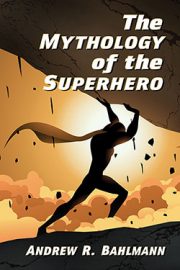Since by now the superhero has become an intrinsic part of the popular culture in Western civilization, a closer look at the reasons why this has happened makes sense. Although his appearance can be traced down exactly to the early and mid-1930s in the US, his mythological origins go way back.
 Bahlmann encounters the superhero as a modern mythological construct and thus builds his research on the existence of mythologies that have been around for several thousand years, like the story of Beowulf.
Bahlmann encounters the superhero as a modern mythological construct and thus builds his research on the existence of mythologies that have been around for several thousand years, like the story of Beowulf.
His Mythology of the Superhero looks for a framework and basic properties of mythologies, so the (present day) function and status of modern superheroes should be easily classifiable.
To do so, a solid explanation of what exactly a myth, or a mythology actually is should be available. As Bahlmann discovers, there are not too many working explanations, since even though there are many approaches to the subject, they all differ in detail. In getting back to approaches to myth by Roland Barthes and then comparing the features of modern-day superhero origins, Bahlmann step by step develops a very similar role and importance in the ancient legends in terms of tales of heroism, daring actions, and unique abilities.
Why and how these new fictional characters took over the roles of their mythological heirs is the topic of six chapters. Maybe the most important text of the book is chapter one “Building a framework: The Lexicon of Superhero Mythology,” where traits and requirements are suggested and evaluated. He tries to identify and locate the several crucial mythemes (integral parts of a mythology) in the short history of the modern superhero.
Needless to say that mythological origins were ascribed to gods, heroes or individuals acting on behalf of religious, national, emotional or divine motivations long before the first comic book superhero was conceived. Central to this mythical superhero figure would be a certain set of superpowers that go hand in hand with the individual character, and also are reflected in his secret identity and even in his real name.
Furthermore, there is a need for a costume and a general aim for selflessness, where the superhero does act on behalf of others, and his actions do not strengthen his own agenda and he must (or should) use means and actions that are mostly sanctioned in the society he lives in. His missions then, must not endanger the current values of this society.
So when finally superhero structures become visible, the (changing and at times constantly altered) mythology sometimes ‘happens’ before our eyes in TV series, movies, mainstream and independent comic books; then the audience becomes part of this process and the re-making of a mythology takes place, to fulfill society’s current need for (a present day) mythology.
However, one of his conclusions after some 170 pages identifies only a limited relatedness of new and old mythologies of heroes.
“The foundational facet of the superhero lies in the origin. Whether this origin is clearly expressed, as was the case with Supermen early on, or unexpressed, as was the case with Wolverine … the implication remains that the superhero’s origins are a critical foundation upon which the character is built. The origin establishes the groundwork for expressing a superhero’s mission and powers and is also commonly a source for understanding the character. Because of this, the origin is central to a mythological understanding of the character.”
The final chapter in the book tests the so far developed theories of traditional and superhero mythology by applying them to SyFy’s Alphas, Buffy the Vampire Slayer, Batman, Beowulf, Green Arrow, and Superman.
Even if just a handful of superheroes are referred to in detail, this title will be gratefully accepted by comic book fans and students of mythology alike.
Review by Dr. A. Ebert © 2017
Andrew R. Bahlmann. The Mythology of the Superhero. McFarland, 2016, 277 p.
